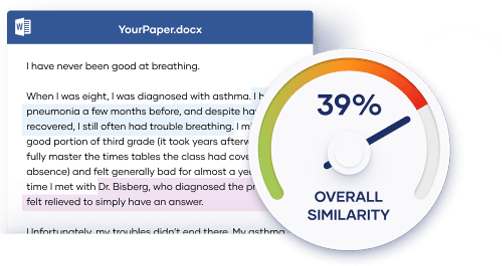How Do Plagiarism Checkers Work?
A plagiarism checker uses advanced database software to scan for matches between your text and existing texts. They are used by universities to scan student assignments. There are also commercial plagiarism checkers you can use to check your own work before submitting.
Behind the scenes, plagiarism checkers crawl web content and index it, scanning your text for similarities against a database of existing content on the internet. Exact matches are highlighted using keyword analysis. Some checkers can also identify non-exact matches (paraphrasing plagiarism).
On the user end, the checker typically provides you with a plagiarism percentage, highlights the plagiarism, and lists the sources. You can get an interactive look at the Scribbr Plagiarism Checker below.
Interactive Scribbr sample report
Differences between plagiarism checkers
While most plagiarism checkers operate similarly, there are some differences between them that affect the kinds of plagiarism they can detect.
To help you choose the best tool, we conducted in-depth research to identify the best plagiarism checkers in 2022. You can also read about the key differences between checkers below.
Database size
Not every plagiarism checker has access to the same database. This can lead to major differences in results.
Free plagiarism checkers often have smaller databases. This means that there are large gaps in their ability to find matches, especially with less readily available online content. The highest-quality plagiarism checkers have larger databases, enhancing their ability to find matches.
Scribbr’s plagiarism checker (which has a free version) has access to a comprehensive database. In addition to web sources, this database also contains scientific publications, scholarly journals, and books.
Quality of scanning
The quality of the scanning software itself also varies widely. Many free checkers only recognise exact matches. If you paraphrased too closely or forgot to add a citation, these checkers are unlikely to flag it.
High-quality plagiarism checkers use a process called ‘fingerprinting’ to find non-exact matches among paraphrased or altered texts.
Here, the software scans sentence fragments, searching for structural similarities. Just like a real fingerprint, each fragment in your text should be completely unique, not matching existing document fingerprints. If there are matches, these checkers are able to identify them.
What plagiarism checkers can’t identify
Although plagiarism checkers are consistently evolving and improving, they can’t recognise everything yet.
Ideas and non-text plagiarism
Plagiarism checkers often struggle to identify plagiarised ideas if they have been completely rewritten or translated. They also can’t help with other non-text plagiarism, such as plagiarism of images.
Plagiarism of translated texts, ideas, images, or other non-text content is still a problem, and has the same consequences as more easily identified plagiarism.
Text from internal databases
In addition to standard plagiarism checkers, most educational institutions also have their own internal database with uploaded work from current and former students.
This database usually isn’t shared with outside parties. This means that plagiarism from fellow students will probably only be recognised by your educational institution—not by a commercial plagiarism checker.
However, sometimes educational institutions share access to their internal database with other institutions, in order to better flag plagiarism or other types of academic dishonesty among students. Self-plagiarism or resubmitting a friend’s work as your own still counts as plagiarism and has the same consequences.
If you’re concerned about accidental plagiarism from unpublished or private documents, such as a previously submitted paper or a friend’s thesis, Scribbr’s Self-Plagiarism Checker can help. With this tool, you can submit documents not available online that may still be in your university’s database.
Frequently asked questions about plagiarism
Cite this Scribbr article
If you want to cite this source, you can copy and paste the citation or click the ‘Cite this Scribbr article’ button to automatically add the citation to our free Reference Generator.
George, T. & Caulfield, J. (2024, October 18). How Do Plagiarism Checkers Work?. Scribbr. Retrieved 9 April 2025, from https://www.scribbr.co.uk/preventing-plagiarism/how-plagiarism-checkers-work/
